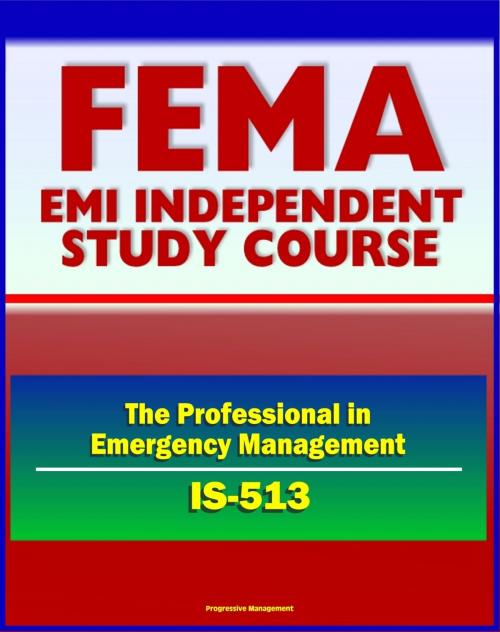21st Century FEMA Study Course: The Professional in Emergency Management (IS-513) - FEMA Organization and History, Disaster Assistance, Mitigation, Exercises, USFA
Nonfiction, Social & Cultural Studies, Political Science| Author: | Progressive Management | ISBN: | 9781465925954 |
| Publisher: | Progressive Management | Publication: | July 19, 2011 |
| Imprint: | Smashwords Edition | Language: | English |
| Author: | Progressive Management |
| ISBN: | 9781465925954 |
| Publisher: | Progressive Management |
| Publication: | July 19, 2011 |
| Imprint: | Smashwords Edition |
| Language: | English |
This Federal Emergency Management Agency (FEMA) independent training course manual from the Emergency Management Institute (EMI) provides extensive information on emergency management.
The introduction states: This course is for any professional in emergency management or anyone who is looking for a career in the profession. You could be asked to respond to questions about hazards that you may not normally encounter and about national level activities outside your community. People expect that capability of professionals.
There are two parts to this book. One part is an orientation to the national assets coordinated by FEMA and the Federal role in disaster management. The other part is devoted to increasing our knowledge of a wider range of hazards. We have joined these two different topics in one book because they represent the broader field of emergency management. If you widen your professional outlook, you may become a more versatile emergency manager. You will be better able to coordinate outside your jurisdiction and to apply your skills to hazards and circumstances in any part of the country.
You are part of a profession that needs people who are flexible, resourceful, and have wide-ranging knowledge and experience. Professionals in emergency management have found employment in agencies and organizations not just in their home communities but throughout this country. They are competent not only with their own jurisdiction’s hazards and local responsibilities, but they are also knowledgeable about many hazards and national level responsibilities. By acquiring this broader background in the profession, you may bring new ideas and innovations to your community and its neighbors, and may contribute at the State, national, and international levels as well.
As a State or local emergency management official, it is your responsibility to know which specific hazards your community faces and be able to identify public safety issues when hazards threaten. Your primary concern in the event of an emergency is to warn citizens and take whatever actions are needed to protect life and property and minimize damage.
Working independently through this course, you will learn about the role of the Federal Emergency Management Agency (FEMA), the types of damage that specific natural and manmade hazards can cause, and how–and under what circumstances–FEMA can help. Through reading assignments and exercises, you will be better prepared to apply the fundamentals of disaster response and recovery for the hazards that affect your community.
This course is designed for self-study. The course includes two sections: The FEMA Organization. This section provides background information to help you understand FEMA’s mission and operations. Planning For and Identifying Community Hazards. This section discusses specific hazards.
Topics covered include: FEMA organization and history; disaster assistance; Stafford Act; Federal Response Plan; mitigation; preparedness and training; exercises; response and recovery; Federal Insurance Administration (FIA); U.S. Fire Administration (USFA); National Flood Insurance Program (NFIP); disaster types and history; National Weather Service products.
This is a privately authored news service and educational publication of Progressive Management.
This Federal Emergency Management Agency (FEMA) independent training course manual from the Emergency Management Institute (EMI) provides extensive information on emergency management.
The introduction states: This course is for any professional in emergency management or anyone who is looking for a career in the profession. You could be asked to respond to questions about hazards that you may not normally encounter and about national level activities outside your community. People expect that capability of professionals.
There are two parts to this book. One part is an orientation to the national assets coordinated by FEMA and the Federal role in disaster management. The other part is devoted to increasing our knowledge of a wider range of hazards. We have joined these two different topics in one book because they represent the broader field of emergency management. If you widen your professional outlook, you may become a more versatile emergency manager. You will be better able to coordinate outside your jurisdiction and to apply your skills to hazards and circumstances in any part of the country.
You are part of a profession that needs people who are flexible, resourceful, and have wide-ranging knowledge and experience. Professionals in emergency management have found employment in agencies and organizations not just in their home communities but throughout this country. They are competent not only with their own jurisdiction’s hazards and local responsibilities, but they are also knowledgeable about many hazards and national level responsibilities. By acquiring this broader background in the profession, you may bring new ideas and innovations to your community and its neighbors, and may contribute at the State, national, and international levels as well.
As a State or local emergency management official, it is your responsibility to know which specific hazards your community faces and be able to identify public safety issues when hazards threaten. Your primary concern in the event of an emergency is to warn citizens and take whatever actions are needed to protect life and property and minimize damage.
Working independently through this course, you will learn about the role of the Federal Emergency Management Agency (FEMA), the types of damage that specific natural and manmade hazards can cause, and how–and under what circumstances–FEMA can help. Through reading assignments and exercises, you will be better prepared to apply the fundamentals of disaster response and recovery for the hazards that affect your community.
This course is designed for self-study. The course includes two sections: The FEMA Organization. This section provides background information to help you understand FEMA’s mission and operations. Planning For and Identifying Community Hazards. This section discusses specific hazards.
Topics covered include: FEMA organization and history; disaster assistance; Stafford Act; Federal Response Plan; mitigation; preparedness and training; exercises; response and recovery; Federal Insurance Administration (FIA); U.S. Fire Administration (USFA); National Flood Insurance Program (NFIP); disaster types and history; National Weather Service products.
This is a privately authored news service and educational publication of Progressive Management.















